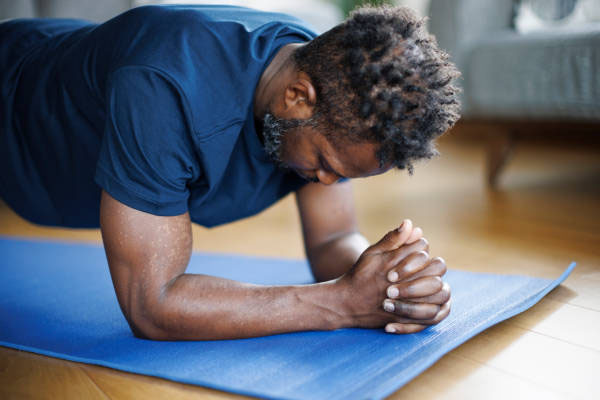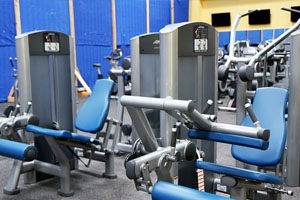Discover the perfect planking duration for your daily exercise routine From beginners to fitness enthusiasts, learn how long you should plank per day to strengthen your core effectively
How long should I plank per day?
When it comes to planking, one common question that arises is, "How long should I plank per day?" Planking is an effective core-strengthening exercise that can yield great results when performed consistently. The ideal duration for your daily plank routine can depend on various factors, including your fitness level, goals, and the quality of your form. In this article, we'll explore the factors to consider when determining your plank duration and provide insights to help you make the most of your planking routine.

Understanding Planking and Its Benefits
Planking is a simple yet highly effective bodyweight exercise that has gained popularity for its ability to strengthen the core and improve overall fitness. This exercise involves maintaining a specific position, similar to a push-up position, but with the body weight resting on your forearms, elbows, and toes. Planking is not only an excellent way to build a strong core but also offers various other health benefits.
Here are some key points to understand about planking and why it's a valuable addition to your fitness routine:
Core Strengthening:
Planking primarily targets the core muscles, including the rectus abdominis, transverse abdominis, and obliques. These muscles play a vital role in stabilizing the spine and promoting good posture.
Improved Posture:
By strengthening the core, planking can help improve your posture. It encourages a neutral spine position, reducing the risk of slouching or developing poor posture habits.
Enhanced Balance:
Planking engages the deep core muscles responsible for balance and stability. This can lead to better coordination and reduced risk of injuries, especially for athletes.
Back Health:
A strong core contributes to better back health. Planking can alleviate lower back pain and reduce the risk of back injuries by providing better support to the spine.
Full-Body Workout:
While planking primarily targets the core, it also engages multiple muscle groups, including the shoulders, back, and legs. It offers a full-body workout in a short period.
Adding planking to your exercise routine, even for just a few minutes a day, can provide significant benefits. Whether you're aiming to build a stronger core, improve posture, or enhance overall fitness, planking is a versatile and accessible exercise.
How to Perform the Plank Exercise Correctly
The plank exercise is simple in concept but requires proper form and technique to maximize its benefits and prevent strain or injury. Here's a step-by-step guide on how to perform the plank exercise correctly:
Step 1: Starting Position
Begin by placing your hands on the ground, directly under your shoulders, keeping your arms straight. Your body should form a straight line from your head to your heels.
Step 2: Engage Your Core
Engage your core muscles by tightening your abs. Imagine pulling your navel towards your spine. This engagement will help stabilize your body.
Step 3: Position Your Elbows
Bend your elbows and rest your weight on your forearms. Your elbows should be directly under your shoulders. Keep your forearms parallel to each other.
Step 4: Maintain a Neutral Neck
Keep your neck in a neutral position by looking down at the ground. Avoid tucking your chin or lifting your head too high. Your head should be in line with your body.
Step 5: Maintain a Straight Line
Ensure that your body forms a straight line from your head to your heels. Your hips should be level, and there should be no sagging or arching in your lower back.
Step 6: Hold the Position
Hold the plank position for as long as you can while maintaining proper form. Beginners may start with 10-20 seconds and gradually increase their time as they become more comfortable.
Step 7: Breathe Normally
Focus on your breathing. Inhale and exhale naturally while holding the plank. Avoid holding your breath, which can lead to tension.
Remember that the quality of your plank is more important than the duration. It's better to hold a proper plank for a shorter time than to compromise form for the sake of a longer hold. Regular practice and consistent effort will lead to improvement in both strength and endurance.
By following these steps and paying attention to your form, you can safely and effectively perform the plank exercise to strengthen your core and enjoy its numerous benefits.
Factors to Consider When Determining Plank Duration
While the plank exercise is an effective way to strengthen your core and improve overall fitness, the duration for which you should hold a plank can vary from person to person. Several factors should be considered when determining the ideal plank duration for your fitness level and goals:
Fitness Level
Your current fitness level plays a crucial role in how long you should hold a plank. Beginners may start with shorter durations, such as 10-20 seconds, while individuals with more experience may aim for longer holds. Gradually increase the duration as your core strength improves.
Goals
Consider your fitness goals. If you're performing planks as part of a core-strengthening routine, a moderate duration is suitable. On the other hand, if you're training for endurance or an advanced fitness challenge, you may work towards longer plank times.
Proper Form
Emphasize maintaining proper form over duration. It's essential to keep a straight line from your head to your heels without arching or sagging. If you can't maintain good form, it's better to hold a shorter plank with proper alignment.
Variations
Planks offer numerous variations, such as side planks, forearm planks, and high planks. The duration can vary depending on the plank variation you choose. Some variations may be more challenging and require shorter holds.
Breathing
Focus on your breathing while planking. Holding your breath can lead to tension, making it harder to maintain good form. Breathe naturally and steadily throughout the plank to stay relaxed and focused.
Consistency
Consistency is key to improvement. Regular practice will help you build core strength and increase your plank duration over time. Set achievable goals, track your progress, and celebrate your milestones.
Ultimately, there is no one-size-fits-all answer to how long you should plank per day. Listen to your body, consider your goals, and progress at your own pace. Over time, you'll build core strength and endurance, and your plank duration will naturally increase.
Benefits of Planking Daily
Engaging in daily plank exercises can offer a range of physical and mental benefits. Here are some of the advantages of making planking a daily habit:
Core Strength
One of the primary benefits of daily planking is improved core strength. Planks target multiple muscle groups in your core, including the rectus abdominis, obliques, and transverse abdominis. A strong core is essential for stability, balance, and maintaining good posture.
Improved Posture
Regular planking helps you develop better posture. Strengthening the muscles around your spine and shoulders can prevent slouching and reduce the risk of back pain. Good posture also enhances your overall appearance and self-confidence.
Enhanced Metabolism
Planks engage a large number of muscles simultaneously, which can boost your metabolism. A faster metabolism can assist in burning more calories throughout the day, making it easier to manage your weight and achieve fitness goals.
Reduced Risk of Injury
Strong core muscles provide stability and support to your spine and reduce the risk of injuries, particularly in the lower back. By reducing strain on your back and improving spinal support, you can prevent common injuries associated with poor core strength.
Better Balance
Planks improve balance and stability by strengthening the core muscles that support your body. Enhanced balance can be beneficial in various physical activities, from sports to everyday tasks, and reduce the risk of falls and injuries.
Mental Benefits
While planks primarily target physical fitness, they can also have mental benefits. Daily planking can help reduce stress and improve mood. Holding a plank position requires concentration, which can clear your mind and offer a mental break.
Adding planks to your daily routine can help you achieve a strong and stable core, better posture, and enhanced overall health. To maximize these benefits, start with a comfortable duration and gradually increase your plank time as your strength improves.
Potential Risks and Precautions
While daily planking can offer numerous benefits, it's essential to be aware of potential risks and take precautions to prevent injury or discomfort. Here are some considerations when incorporating planks into your daily routine:
Neck and Shoulder Strain
Improper plank form can lead to neck and shoulder strain. To avoid this, keep your neck aligned with your spine and your gaze on the floor. Ensure your shoulders are directly above your wrists, and distribute your weight evenly between both arms.
Lower Back Discomfort
Planking can put stress on your lower back if not done correctly. To reduce the risk of lower back discomfort, maintain a straight line from your head to your heels. Engage your core muscles to provide support and avoid sagging in the lower back.
Wrist Pain
Extended plank sessions may lead to wrist pain. To mitigate this, make sure your wrists are under your shoulders and your hands are flat on the ground. You can also use padded surfaces or yoga mats for added wrist support.
Overtraining
While daily planking can be beneficial, it's important not to overtrain. Listen to your body and give your muscles time to recover. Incorporate rest days into your routine to prevent overuse injuries.
Modifications and Progressions
If you're new to planking, consider starting with modified planks on your knees. As you build strength, gradually progress to full planks. This stepwise approach can help prevent injury and ensure that you're working within your current fitness level.
Consulting a Professional
If you have underlying health conditions, injuries, or concerns, it's advisable to consult a fitness professional or healthcare provider before beginning a daily plank routine. They can provide personalized guidance and ensure that planking is safe for you.
Remember that quality and proper form are more important than duration. Start with a comfortable plank time and increase it gradually as your strength improves. If you experience persistent pain or discomfort, consult a healthcare professional.
FAQs About Planking Duration
Q1: How long should I hold a plank as a beginner?
A: If you're new to planking, aim to hold a plank for 20-30 seconds. Focus on maintaining proper form, such as a straight line from your head to heels. As you build strength and endurance, gradually increase the duration.
Q2: What's the ideal duration for intermediate planks?
A: For intermediate planks, try to hold for 45-60 seconds. This duration allows you to challenge your core and gradually progress. Ensure that your form remains correct throughout the plank.
Q3: Can I do planks for more than a minute for better results?
A: Yes, you can hold planks for longer durations as you advance. However, it's essential to prioritize form and quality over time. Extending plank times beyond 60 seconds may lead to diminished returns and increased risks if not performed correctly.
Q4: Are shorter planks effective?
A: Shorter planks can be effective, especially if you're performing high-intensity variations. Planks as short as 10-20 seconds can engage your core and provide benefits. Just ensure that you're challenging yourself with proper form.
Q5: Can I plank every day, and for how long?
A: It's possible to plank daily, but it's essential to vary your routine. Start with 20-30 seconds per set and gradually increase duration or incorporate different plank variations. Listening to your body and allowing for rest days is important to prevent overuse injuries.










